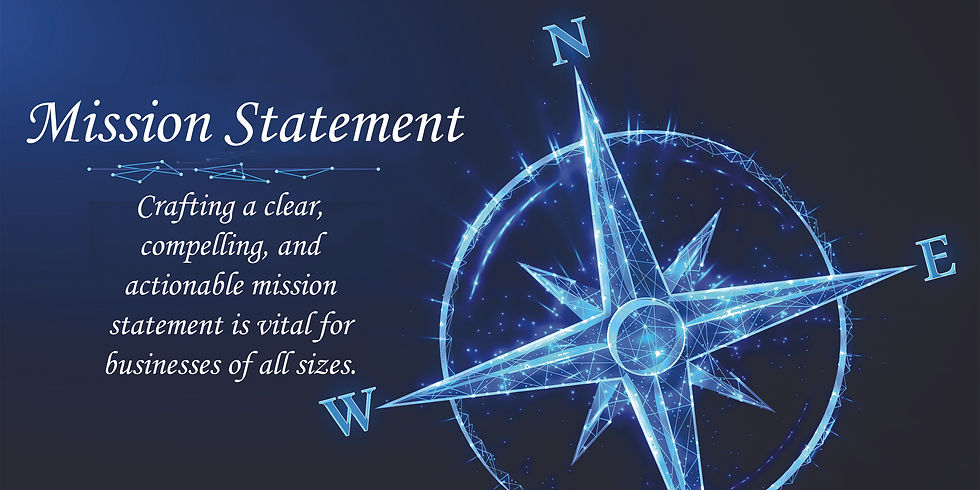Crafting an Excellent Business Mission Statement: A Comprehensive Guide
- Jeff Mayfield

- Nov 29, 2024
- 6 min read
Updated: Mar 14, 2025
Introduction
A mission statement serves as the foundation of a business's identity. It defines the purpose of the organization, outlines its core values, and guides its strategic direction. Crafting a clear, compelling, and actionable mission statement is vital for businesses of all sizes, as it not only communicates the company's purpose to its employees, customers, and stakeholders but also sets the stage for achieving long-term goals.
In this blog post, we will explore the essential components of an excellent business mission statement, explain why each component is crucial, and outline the benefits your customers receive from a well-crafted mission statement. Additionally, we will provide a step-by-step implementation plan for writing a mission statement, ensuring that your business can articulate its purpose and values effectively.

Components of an Excellent Business Mission Statement
Purpose:
The mission statement should clearly define the fundamental purpose of the business. This involves answering the question, "Why does the company exist?" A well-articulated purpose reflects the core reason for the business's existence beyond making a profit, such as solving a particular problem, fulfilling a specific need, or making a positive impact on society.
Importance:
Defining the purpose helps align the organization's efforts, ensuring that every action taken supports the overarching goal. It also resonates with customers and employees who share similar values, fostering loyalty and engagement.
Values:
The mission statement should highlight the core values that guide the business's operations and decision-making processes. These values represent the principles the company stands for, such as integrity, innovation, customer-centricity, or sustainability.
Importance: Values serve as the ethical compass for the business, influencing its culture and shaping the behavior of employees. When clearly communicated, values attract like-minded customers and partners who support and appreciate the company's commitment to these principles.
Vision :
While the mission statement is different from a vision statement, it should hint at the long-term impact the company aims to achieve. This component provides a sense of direction and future aspirations, helping to inspire both employees and customers.
Importance: A vision embedded within the mission statement gives the company a forward-looking perspective, motivating stakeholders to work towards a common goal. It also sets the stage for strategic planning and innovation.
Target Audience:
The mission statement should identify the primary audience the business serves. This includes specifying the customer segments, industries, or communities that the company aims to impact through its products or services.
Importance:Clearly defining the target audience helps the business focus its efforts on meeting the needs and expectations of its most important stakeholders. It also guides marketing strategies and product development, ensuring alignment with customer needs.
Unique Selling Proposition (USP):
The mission statement should convey what sets the business apart from its competitors. The USP highlights the distinctive qualities, products, or services that make the company unique and valuable to its customers.
Importance:Articulating the USP differentiates the business in a crowded market, attracting customers who are seeking something specific that only the company can provide. It also reinforces the brand's identity and competitive advantage.
Commitment to Stakeholders:
The mission statement should reflect the company's commitment to its various stakeholders, including customers, employees, shareholders, and the community. This component emphasizes the company's dedication to creating value for all parties involved.
Importance:Acknowledging the importance of stakeholders fosters trust and transparency, which are crucial for building long-term relationships. It also demonstrates the company's broader responsibility and ethical considerations.
Benefits Customers Receive from a Well-Crafted Mission Statement
Clarity and Trust:
A clear mission statement provides customers with a transparent understanding of the company's purpose and values. This clarity fosters trust, as customers know exactly what the company stands for and what to expect from its products or services.

Alignment with Values:
When a mission statement reflects values that resonate with customers, it creates a sense of alignment and shared purpose. Customers are more likely to support a business that embodies values they care about, leading to increased loyalty and advocacy.
Consistency and Reliability:
A strong mission statement ensures consistency in the company's actions and decisions, which in turn makes the business more reliable in the eyes of customers. Consistency in upholding the mission reinforces the brand's promise and builds long-term customer relationships.
Inspiration and Motivation:
Customers are often inspired by companies that aim to make a positive impact or achieve a greater good. A mission statement that communicates this vision can motivate customers to engage with the brand, participate in its initiatives, and spread the word.
Enhanced Customer Experience:
By clearly defining the target audience and USP, a mission statement helps the business tailor its offerings to meet customer needs more effectively. This results in a better overall customer experience, as the company is more attuned to delivering value that resonates with its audience.
Implementation Plan for Writing a Mission Statement
Creating a mission statement involves a thoughtful and strategic process. Below is a detailed step-by-step implementation plan for writing a mission statement:
Assemble a Diverse Team:
Gather a team of key stakeholders, including executives, employees, and representatives from various departments. This team should have a deep understanding of the company's operations, culture, and goals.
Action Step:Schedule a series of brainstorming sessions and workshops to ensure that all perspectives are considered.
Conduct a Purpose Exploration:
Engage the team in a discussion to explore the fundamental purpose of the business. This involves asking critical questions such as "Why do we exist?" and "What impact do we want to have on our customers and the world?"
Action Step:Document the key insights and themes that emerge from the discussion.
Identify Core Values:

Define the core values that guide the company's actions and decisions. These values should reflect the principles the company is committed to upholding in its interactions with customers, employees, and other stakeholders.
Action Step:Create a list of potential values and refine them to align with the company's culture and vision.
Analyze the Target Audience:
Clearly define the primary audience the business serves. This includes identifying customer segments, industries, or communities that are central to the company's mission.
Action Step:Develop customer personas and use them to guide the formulation of the mission statement.
Determine the Unique Selling Proposition (USP):
Highlight what sets the company apart from its competitors. The USP should be a central element of the mission statement, emphasizing the unique value the company offers to its customers.
Action Step:Review the company's products, services, and market position to articulate the USP effectively.
Incorporate the Vision:
Infuse the mission statement with a sense of the company's long-term aspirations and impact. This vision should inspire and motivate both internal and external stakeholders.
Action Step:Draft a vision statement and integrate it into the mission statement in a way that complements the company's purpose and values.
Draft the Mission Statement:
Combine the insights from the previous steps to draft a concise and compelling mission statement. The statement should be clear, actionable, and easy to understand, reflecting the company's identity and goals.
Action Step:Write multiple drafts and refine them based on feedback from the team.
Seek Feedback and Refine:

Share the draft mission statement with a broader group of stakeholders, including employees, customers, and partners. Gather feedback to ensure the statement resonates with the intended audience.
Action Step:Make necessary revisions to the mission statement based on the feedback received.
Finalize and Communicate:
Once the mission statement is finalized, communicate it across the organization and to external stakeholders. Ensure that the statement is prominently displayed on the company's website, marketing materials, and internal documents.
Action Step:Launch an internal and external communication campaign to promote the mission statement and its significance.
Embed the Mission in the Company Culture:
Integrate the mission statement into the company's daily operations and decision-making processes. Ensure that all employees understand and embrace the mission as a guiding principle.
Action Step:Conduct training sessions and workshops to reinforce the mission statement and its importance to the company's success.
Conclusion
A well-crafted mission statement is more than just a declaration of a company's purpose; it is a powerful tool that aligns the organization, motivates employees, and resonates with customers. By clearly defining the purpose, values, vision, target audience, USP, and commitment to stakeholders, a business can create a mission statement that serves as a beacon for its strategic direction.
The benefits of a strong mission statement extend beyond the company itself, as customers gain clarity, trust, and a sense of alignment with the brand. By following the implementation plan outlined in this blog, your business can develop a mission statement that not only articulates its identity but also drives long-term success and customer satisfaction.
In conclusion, the process of crafting an excellent mission statement is a strategic endeavor that requires careful consideration and collaboration. When done effectively, it can serve as a cornerstone of your business, guiding your decisions, actions, and relationships with customers for years to come.
LET'S WORK TOGETHER

Are you seeking someone with a proven track record who can navigate adversity, drive growth, and inspire teams? I am eager to bring my skills and expertise to leaders and professionals ready to take bold steps toward achieving their mission and vision. I offer a partnership grounded in experience, dedication, and a relentless pursuit of excellence.
Let’s work together to transform your challenges into opportunities and your aspirations into accomplishments. Contact me for free 30 minute consultation at jeff@jeffmayfield.org .
Blessings and Success
Jeff Mayfield



